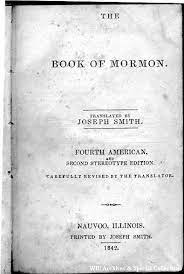Articles/Essays – Volume 25, No. 3
Mormon-Gentile Conflict in Illinois Reconsidered? | Annette P. Hampshire, Mormonism in Conflict: The Nauvoo Years
Annette Hampshire’s Mormonism in Conflict: The Nauvoo Years is simultaneously refreshing and exasperating. To her credit, Hampshire strives for a degree of methodological and theoretical rigor that has been sadly absent in most Mormon historiography. This effort is highly laud able, but the result is less so.
Hampshire states the goal of her study is to utilize “sociology in an effort to write better history. .. . to use sociological concepts to help unpick the situation; to ask more searching questions of the primary source material, to move more effectively away from the citation of causes towards the explanation of process” (pp. 8-9).
Hampshire assigns herself a difficult and in some ways contradictory task: she resolves to be both a historian describing the particulars of Mormon-Gentile conflict in 1840s Illinois and a social scientist seeking to generalize in the interest of furthering sociological theory. Alas, Hamp shire does not fully succeed in this balancing act nor, more importantly, in formulating a significantly new perspective of her topic. The end result of Mor monism in Conflict’s “explanation of process” differs little from the “citation of causes” which it seeks to supplant.
Hampshire sets the stage by asserting that non-Mormons in Illinois, before the mass arrival of the Latter-day Saints, exhibited uncertain feelings about the Mormons. These equivocal opinions turned to sympathy as the Mormon refugees arrived from Missouri in a pitiable condition. Enthusiasm for the Saints’ presence grew as the Gentile residents of Illinois recognized they represented a potential economic godsend to the state’s depressed economy in the aftermath of the Panic of 1837. In addition, “The people of Illinois now had the opportunity to demonstrate their superiority over slaveholding Missouri in terms of Illinois’ higher capacity for tolerance and benevolence” (p. 29). Hampshire plays down the effect of the Mormon swing vote in either state or county politics, as a fac tor in the initial good feelings.
She contends that Mormon-Gentile conflict in Illinois developed in four dis tinct phases or “thresholds.” First, certain old residents came to realize the Latter day Saints deviated from and could potentially disrupt the established social order. The Mormons did not integrate into the existing Hancock County citizenry but established a separate community (Nauvoo) within it, while simultaneously seeking to utilize the region’s political, eco nomic, and religious institutions for their own ends.
Second, non-Mormons discovered that they could not control Mormon deviance through existing legal means. Lawful methods failed both to repeal the Nauvoo Charter and to extradite Joseph Smith to Missouri. Hampshire believes these critical events contributed to an unevenly growing but serious frustration with the Latter-day Saints after 1841.
Third, as both Mormons and Gentiles came to believe they could not obtain impartial justice, and the Gentiles perceived they had no legal means to control Mormon deviance, extralegal violence in the name of the law became acceptable. Hampshire wisely adds that rioting was not inevitable until a loose anti-Mormon coalition mobilized after the Expositor incident, and after a disbanded, anti-Mormon Nauvoo-bound militia was transformed into a lynch mob that successfully assassinated Joseph and Hyrum Smith, who were being held at the Carthage Jail.
Finally, violence persisted after the Smiths’ murders, not only because Mormons continued to practice their peculiar faith and hold themselves apart in Hancock County, but also because anti Mormons now knew they could wrest authority from the legitimate but ineffective agents of the government (notably Governor Ford) and bestow it on themselves. Extralegal violence continued, now directed at the new Gentile residents of Nauvoo in addition to the few remaining Mormons, to further legitimate the earlier use of such tactics.
Despite her novel sociological approach, Hampshire’s ultimate interpretation of the Mormon-Gentile conflict differs little from Robert Flanders’ in his classic narrative history, Nauvoo: Kingdom on the Mississippi (University of Illinois Press, 1965). Both hold that the conflict between Illinois Mormons and Gentiles was a political, social, and economic dispute about different visions of the region’s future. While Hampshire’s approach has value, the sociology she used to improve the writing of history has produced an interpretation indistinct from that of a narrative historian. She bakes the cake with a new recipe, but it tastes much the same nonetheless.
Indeed, if Mormonism in Conflict illustrates anything, it is the value of history for improving sociological theory. Hamp shire herself admits about the riots of 1844:
One can see that they aptly illustrate the limits of generalized explanation and the importance of immediate situational factors. One can, in sociological fashion, identify factors predisposing the situation towards a violent outcome. . . . But these are not sufficient conditions for violence—opportunity was also necessary and the circumstances constituting “opportunity” in this case are not generalizable beyond the particular event, (pp. 214-15)
In short, Hampshire recognizes that social science generalizations are limited and depend on historical considerations inher ent in any time and place. Her realization reaffirms the value of history in Mormon studies.
I must also mention two minor criticisms. First, Mormonism in Conflict does not take the pains, particularly in the intro duction, to adequately explain the socio logical theories for a lay reader. Second, although Hampshire commendably uses numerous non-Hancock County Illinois newspapers, she could also have profited from using more manuscript sources.
However, despite her inability to wrest a distinctive interpretation of Mormon Gentile conflict in Illinois from her novel sociological perspective, her work could be valuable to social scientists and to those interested in violence in Mormon history—if, for no other reason, than to remind them of the value of the historical perspective.
Mormonism in Conflict: The Nauvoo Years by Annette P. Hampshire, Studies in Religion and Society, Volume 11 (New York and Toronto: The Edwin Mellen Press, 1985), 343 pp.


 Back to full Issue
Back to full Issue

